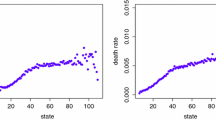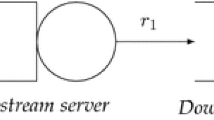Abstract
In this paper we consider the multiplexing of independent stochastic fluid sources onto a single buffer. The rate at which a source generates fluid is assumed to be modulated by a Markov regenerative process. We develop the exponential decay rates for the tails of the steady-state distribution of the buffer content. We also develop expressions for the effective bandwidths for such sources. All the results are in terms of the Perron-Frobenius eigenvalue of a matrix defined for the Markov regenerative source. As a special case we derive similar results for regenerative sources. We apply the results to video sources.
Similar content being viewed by others
References
J. Abate, G.I. Choudhury and W. Whitt, Asymptotics for steady-state tail probabilities in structures Markov queueing models,Commun. Statist. Stoch. Models 10 (1994) 99–143.
J. Abate, G.I. Choudhury and W. Whitt, Exponential approximations for tail probabilities in queues I: waiting times,Oper. Res., to appear.
J. Abate, G.I. Choudhury and W. Whitt, Exponential approximations for tail probabilities in queues II: sojourn time and workload,Oper. Res., to appear.
D. Anick, D. Mitra and M.M. Sondhi, Stochastic theory of a data handling system with multiple sources,Bell Syst. Tech. J. 61 (1982) 1871–1894.
S. Asmussen, Stationary distributions for fluid models with or without Brownian noise,Commun. Statist. Stoch. Models 11 (1995) 21–49.
C.S. Chang, Stability, queue length and delay, Part II: stochastic queueing networks, in:Proc. IEEE CDC, Tucson, AZ (1992) pp. 1005–1010.
C.S. Chang and J.A. Thomas, Effective bandwidth in high-speed networks,IEEE JSAC 13 (1995) 1091–1100.
E. Cinlar,Introduction to Stochastic Processes (Prentice-Hall, Engelwood Cliffs, NJ, 1975).
N.G. Duffield and N. O'Connell, Large deviations and overflow probabilities for the general single-server queue, with applications, Preprint (1993).
H. Dupuis and B. Hajek, A simple formula for mean multiplexing delay for independent regenerative sources,Queueing Systems 16 (1994) 195–239.
A.I. Elwalid and D. Mitra, Statistical multiplexing of Markov modulated sources: theory and computational algorithms,Teletraffic and Datatrafflc in a Period of Change, ITC-13 (1991) pp. 495–500.
A.I. Elwalid and D. Mitra, Effective bandwidth of general Markovian traffic sources and admission control of high speed networks,IEEE/ACM Trans. Networking 1 (1993) 329–343.
W. Feller,An Introduction to Probability Theory and Its Applications, Vol 2, 2nd ed. (Wiley, New York, 1971).
R.J. Gibbens and P.J. Hunt, Effective bandwidths for multitype UAS channels,Queueing Systems 9 (1991) 17–28.
P.W. Glynn and W. Whitt, Logarithmic asymptotics for steady-state tail probabilities in a single-server queue, in:Studies in Applied Probability, eds. J. Galambos and J. Gani,J. Appl. Prob. 31A (special vol.) (1994) 131–156.
G.H. Golub and C.F. van Loan,Matrix Computations (The Johns Hopkins University Press, Baltimore, MD, 1983).
D.P. Heyman and M.J. Sobel,Stochastic Models in Operations Research, Vol. 1 (McGraw Hill, NY, 1982).
D.P. Heyman and T.V. Laxman, Statistical analysis and simulation study of video teleconference traffic in ATM networks,IEEE Trans. Circuits and Syst. Video Tech. 2 (1992) 49–59.
F.P. Kelly, Effective bandwidths for multiclass queues,Queueing Systems 9 (1991) 5–15.
G. Kesidis, J. Walrand and C.S. Chang, Effective bandwidths for multiclass Markov fluids and other ATM sources,IEEE/ACM Trans. Networking 1 (1993) 424–428.
J.F.C. Kingman, A convexity property of positive matrices,Quart. J. Math., Ser. 2, 12 (1961) 283–284.
J.F.C. Kingman, Inequalities in the theory of queues,J. Roy. Statist. Soc. B32 (1970) 102–110.
V.G. Kulkarni and T. Rolski, Fluid model driven by an Ornstein Uhlenbeck process,Prob. Eng. Inform. Sci. 8 (1995) 403–417.
V.G. Kulkarni, Fluid models for single buffer systems, in:Frontiers in Queueing: Models and Applications in Science and Engineering, ed. J.H. Dshalalow (CRC Press, Boca Raton, Florida, to appear).
V.G. Kulkarni,Modeling and Analysis of Stochastic Systems (Chapman-Hall, NY, 1995).
V.G. Kulkarni and R.L. Karandikar, Second order fluid flow models: reflected Brownian motion in a random environment,Oper. Res. 43 (1995) 77–88.
W.E. Leland, M.S. Taqqu, W. Willinger and D.V. Wilson, On the self similar nature of Ethernet traffic (extended version),IEEE/ACM Trans. Networking 2 (1994) 1–15.
B. Melamed and B. Sengupta, TES Modeling of video traffic,IEICE Trans. Commun. E75-B(5) (1992) 1292–1300.
D. Mitra, Stochastic theory of a fluid model of producers and consumers coupled by a buffer,Adv. Appl. Prob. (1988) 646–676.
A. Narayanan and V.G. Kulkarni, First passage times in fluid models with an application to two priority fluid systems, to appear inProc. IPDS 96.
M.F. Neuts, The caudal characteristic curve of queues,Adv. Appl. Prob. 18 (1986) 221–254.
P. Ney and E. Nummelin, Markov additive processes I: eigenvalue properties and limit theorems,Ann. Prob. 15 (1987) 561–592.
P. Ney and E. Nummelin, Markov additive processes II: Large deviations,Ann. Prob. 15 (1987) 593–609.
N.U. Prabhu and A. Pacheco, A storage model for data communication systems,Queueing Systems 19 (1995) 1–40.
S.M. Ross, Bounds on the delay distribution in GI/G/1 queue,J. Appl. Prob. 11 (1974) 417–421.
E. Seneta,Non-negative Matrices and Markov Chains, 2nd ed. (Springer, NY, 1973).
A. Simonian, Stationary analysis of a fluid queue with input rate varying as an Ornstein-Uhlenbeck process,SIAMJ. Appl. Math. 51 (1991) 823–842.
A. Simonian, and J. Virtamo, Transient and stationary distributions for fluid queues and input processes with a density,SIAM J. Appl. Math. 51 (1991) 1731–1739.
K. Sohraby, On the theory of general on-off sources with applications in high speed networks,Proc. INFOCOM'93, San Fransisco (1993) pp. 401–410.
T.E. Stern and A.I. Elwalid, Analysis of separable Markov modulated rate models for information handling systems,Adv. Appl. Prob. 23 (1991) 105–139.
H.C. Tijms,Stochastic Modeling and Analysis: A Computational Approach (Wiley, New York, 1986).
Author information
Authors and Affiliations
Additional information
This research was partially supported by NSF Grant No. NCR-9406823.
Rights and permissions
About this article
Cite this article
Kulkarni, V.G. Effective bandwidths for Markov regenerative sources. Queueing Syst 24, 137–153 (1996). https://doi.org/10.1007/BF01149083
Issue Date:
DOI: https://doi.org/10.1007/BF01149083




